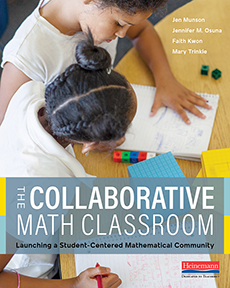
Collaborative and cooperative approaches to learning mathematics that center reasoning and reflection are effective, engaging, and equitable for students, though ambitious work for teachers. It is worth putting in the hard work of creating a collaborative math classroom, full of mathematical inquiry and reflection, and in this book we will walk you through the steps of how to create one with and for your students.
When teachers shift roles toward supporting and orchestrating collaborative mathematics experiences among students, they also hand over more of the thinking work to students. Students take on the authority to author and evaluate mathematical ideas. During small-group or partner work, students take on even more of the thinking work since they are largely on their own while the teacher moves from group to group. Students also claim greater agency in how they participate in classroom tasks: they think about mathematics problems in different ways, and all of these ideas might be at play as students make sense of them together.
In this sample you will find:
© 2024 Heinemann. A division of Houghton Mifflin Harcourt.
Permissions Request Disability Request
Website Terms of Use Privacy Policies